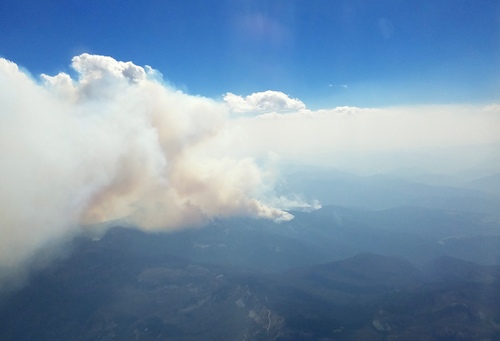1C: The Western Wildfire Experiment for Cloud Chemistry, Aerosol Absorption and Nitrogen (WE-CAN) field campaign
Western wildfire smoke has a significant impact on air quality, nutrient cycles, weather and climate. The chemistry inside a smoke plume during the first 24 hours after emission affects reactive nitrogen partitioning, cloud chemistry and nucleation, and aerosol scattering and absorption, all of which can impact air quality and climate.
The NSF-funded WE-CAN ground-based and airborne field campaign aimed to systematically characterize the emissions and first 24 hours of smoke plume evolution from western U.S. wildfires. The project, led by Dr. Emily Fischer at Colorado State University, focused on three science questions related to better quantifying processes associated with fixed nitrogen, absorbing aerosols, and cloud activation and chemistry in wildfire plumes. WE-CAN deployed a large suite of measurement instruments run by both university and NCAR teams on the NSF/NCAR C-130 and also involved a ground-based mobile component.
The C-130 was based in Boise, Idaho from 20 July – 31 August 2018 to maximize the opportunities to sample smoke plumes from northwestern wildfires in California, Oregon, Washington, Idaho, Montana, Utah, Nevada, and Colorado during the peak of the 2018 fire season. All three sampling goals of WE-CAN were achieved. In all, during the 16 research flights based out of Boise, 21 different wildfire plumes were sampled, each with a detailed fuel assessment provided by the local regional Fire Service. Following the research science portion of the field campaign, a subset of the instruments were run during an educational component, involving three flights based out of Broomfield, Colorado over a two-week period in early September 2018. During these flights, the C-130 sampled smoke plumes from two more fires, including a prescribed fire in Colorado.
Several ACOM teams deployed measurement instruments on the C-130 for WE-CAN, including the Trace Organic Gas Analyzer (TOGA; PI Eric Apel, Rebecca Hornbrook, Alan Hills), the HIAPER Airborne Radiation Package (HARP) actinic flux measurement (PI Sam Hall, Kirk Ullmann), the PAN Chemical Ionization Mass Spectrometer (PAN-CIMS; PI Frank Flocke), a Picarro CO-CO2-CH4 instrument and an Aerodyne Research Inc. CO-N2O-H2O instrument (PI Teresa Campos), and the NO-NO2-O3 (PI Andy Weinheimer, Denise Montzka, Geoff Tyndall). Preliminary data submissions for most data sets are due by 15 November 2018, and final quality controlled data are due 15 March 2019. Preliminary analyses will be presented by many teams at a targeted session at the 21st Conference on Atmospheric Chemistry at the AMS Annual Meeting in Phoenix, Arizona in January 2019.

Contact
Please direct questions/comments about this page to:
Carl Drews
NSF NCAR | Research IT | ACOM